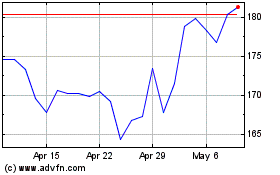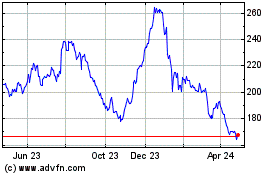Airbus and Boeing Leave Air Show With Work to Do--Update
July 14 2016 - 1:42PM
Dow Jones News
By Robert Wall and Jon Ostrower
FARNBOROUGH, England -- Boeing Co. and Airbus Group SE
executives are wrapping up the commercial-aviation industry's
biggest week of the year. But instead of jetting off to summer
vacation, it feels more like the start of summer school for both
plane makers.
The rivals came away from the biennial Farnborough air show with
a combined haul of nearly $62 billion in deals, compared with
$115.5 billion they racked up at the last show here. That was in
the midst of a historic boom in orders, driven by rapidly expanding
airlines looking for the newest, most efficient planes.
The midsummer show tends to be the industry's orders highlight
of the year, when plane makers pack their annual orders books and
position themselves for an easy glide in the latter half of the
year toward making their closely watched year-end forecasts. This
year, though, executives at both companies said they would have
significant work to do after the show to make those goals.
Airbus secured $35 billion in deals at the show, bringing its
annual haul so far to 380 firm orders. Boeing came away with $26.8
billion in deals, bringing it up to 321 firm orders for the
year.
For Airbus, that still leaves a lot of planes to sell before
reaching its 650-order, year-end goal. The plane maker's chief
operating officer for customers, John Leahy, said Thursday that the
target was still attainable, though it won't be easy.
Three years ago in Paris, which alternates each year with
Farnborough as the host of the big show, Mr. Leahy quipped he could
hang a "gone fishing" sign on his door after a flood of orders back
then. This year, he said "we have a lot of running to do."
Boeing has set about 740 orders as its 2016 target. Randy
Tinseth, Boeing's commercial marketing vice president, said the
company was "on track" to meet that target. Still, its chief
salesman, John Wojick, said it had "a lot of work to do through the
end of the year."
Widebody sales have been a particular weakness for the two plane
makers in recent months. That is a headache particularly for
Boeing, which is under pressure to sell more current-generation 777
long-range planes to keep production humming until it transitions
to a replacement model. It has already planned one output cut for
the plane in 2017.
Boeing failed to secure any 777 deals here. It has booked orders
for only eight this year. The company is trying to book as many as
50 planes a year to avoid another cut in its most profitable
twin-aisle jet.
For Airbus, the order lull isn't one of its biggest problems.
The company stole the show, not with the sort of jaw-dropping
orders that has been the norm in recent years, but with its
decision to cut sharply production of its long-troubled A380
double-decker.
Fabrice Brégier, the head of Airbus's plane-making unit, said
that dramatic step wasn't his biggest problem. Instead, it is
scrambling to deliver upgraded models of its workhorse short-haul
A320 and its long-haul A350. But upgrades are behind schedule,
angering airline customers and weighing on cash flow.
"The A380 is my marginal challenge. My challenge is the A320 and
A350," he said.
Mr. Brégier said engine issues that held back A320 deliveries
appear resolved. Some of the A350 supplier problems also are
starting to improve, though not all.
With near-record backlogs and record promised deliveries, both
plane makers also have to push hard on the factory floor, too, to
build all the planes they have sold.
They have homework to do on their military programs.
Boeing secured orders from the U.K. for nine P-8A
submarine-hunting planes and 50 Apache attack helicopters. But it
is still trying to overcome development problems on its KC-46A
refueling plane for the U.S. Air Force. The company is testing a
fix to the plane's telescoping refueling boom -- used to gas up
other planes in flight.
Airbus's A400M transport plane remains a persistent headache.
The company this week warned investors that a series of earnings
hits related to program changes lies ahead. The company is
adjusting delivery plans for the plane to air force customers,
while still struggling with features promised to customers.
Analysts expect the program, already in the red, to face an
additional EUR1.5 billion ($1.7 billion) in costs.
Write to Robert Wall at robert.wall@wsj.com and Jon Ostrower at
jon.ostrower@wsj.com
Write to Robert Wall at robert.wall@wsj.com and Jon Ostrower at
jon.ostrower@wsj.com
(END) Dow Jones Newswires
July 14, 2016 13:27 ET (17:27 GMT)
Copyright (c) 2016 Dow Jones & Company, Inc.
Boeing (NYSE:BA)
Historical Stock Chart
From Mar 2024 to Apr 2024

Boeing (NYSE:BA)
Historical Stock Chart
From Apr 2023 to Apr 2024
